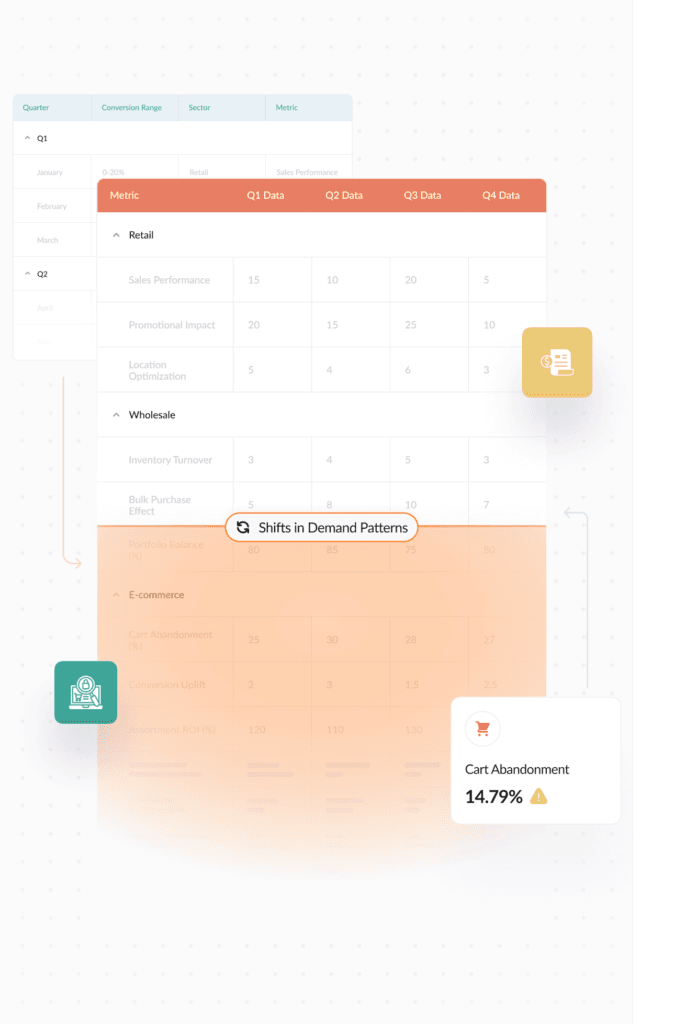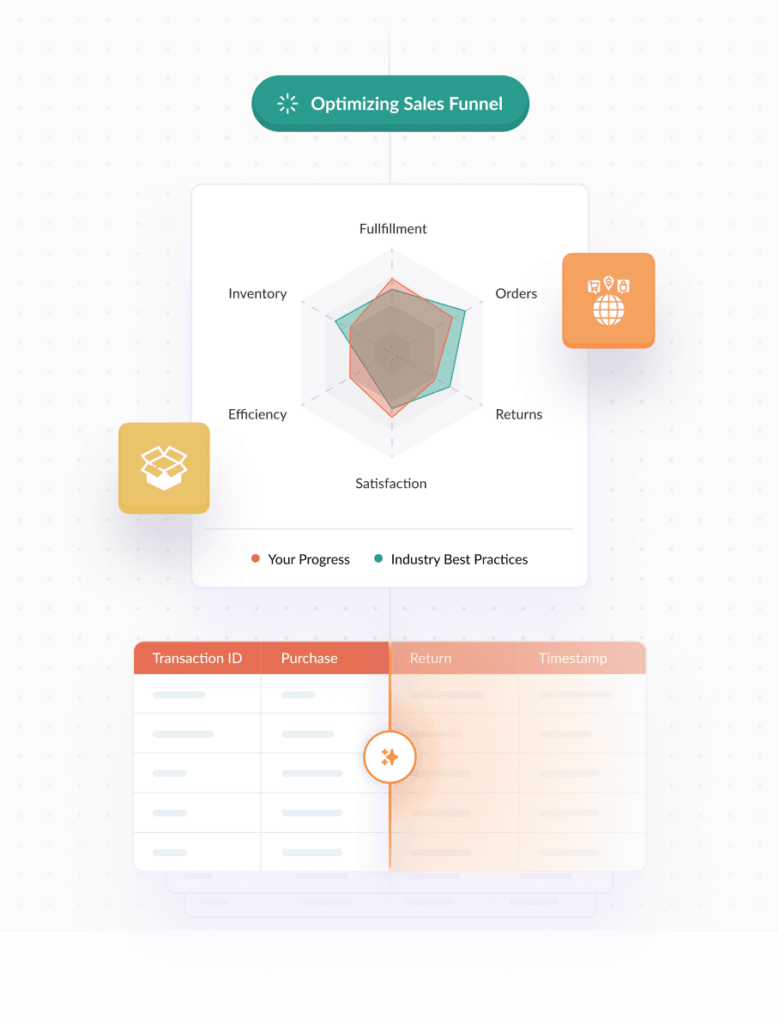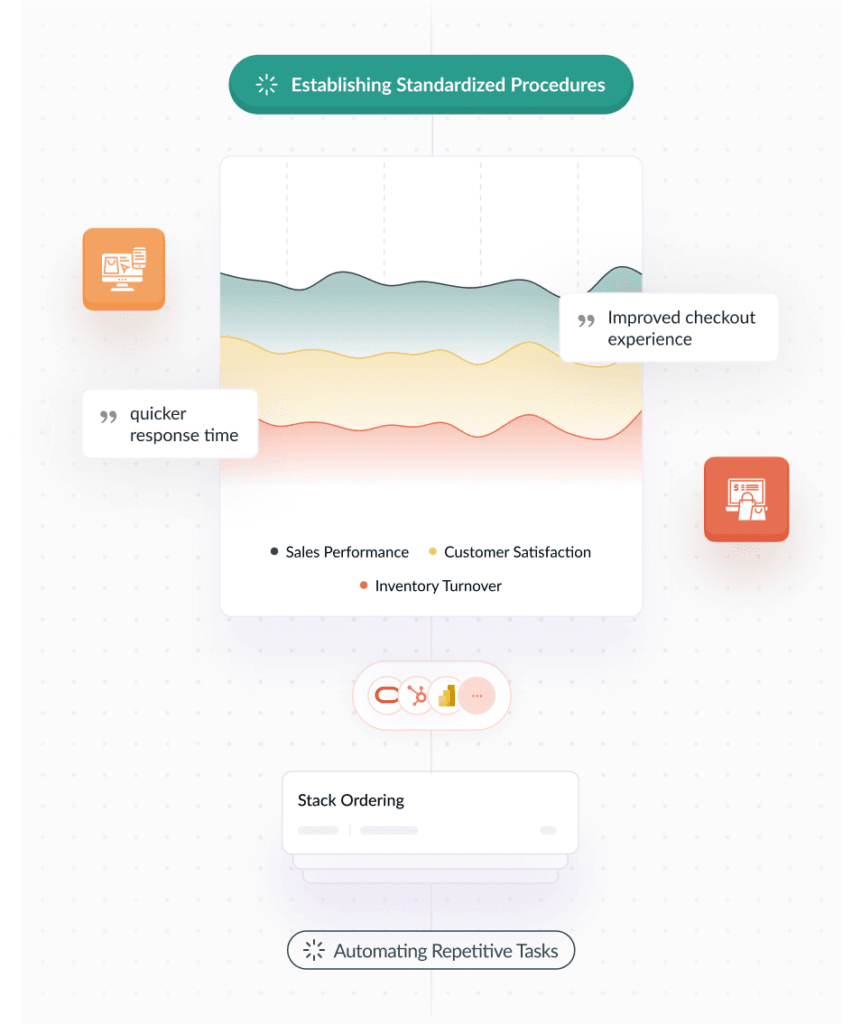Retail, Wholesale,
E-Commerce

Financial & Capital Analytics
Retail: Analyze sales performance across different channels (in-store, online) and assess the impact of seasonal trends and promotional campaigns on financial health
Wholesale: Evaluate bulk purchase agreements, inventory turnover rates, and their effect on working capital
E-commerce: Scrutinize digital sales metrics, including cart abandonment rates and conversion ratios, to refine revenue projections
Note: Quite a number of e-merchants think their current cart abandonment rates are all right when they are not. Cart abandonment rates provide valuable insights into so many aspects of an e-merchant’s operations and customer experience, they can’t afford to disregard. Yet disregard they do.
Retail: Optimize store portfolios by analyzing location-based sales data and identifying underperforming outlets for closure or transformation
Wholesale: Balance the portfolio of suppliers and clients to reduce overreliance on a single source and mitigate risks
E-commerce: Implement advanced analytics to enhance product assortment strategies and improve return on investment for marketing campaigns
Retail: Conduct deep dives into consumer behavior trends, such as the shift towards experiential shopping and sustainability preferences
Wholesale: Investigate market demand fluctuations and emerging trends in bulk purchasing and distribution
E-commerce: Analyze online shopping behaviors, including peak shopping times and preferred payment methods, to optimize user experience
Retail: Develop financial models that incorporate variable costs associated with staffing, rent, and seasonal inventory fluctuations
Wholesale: Create models to forecast cash flows based on varying supply chain scenarios and bulk order volumes
E-commerce: Use predictive analytics to model future sales growth, factoring in digital marketing spend and technological investments
Retail: Optimize the capital structure by balancing lease obligations with debt and equity to ensure sustainable store expansion
Wholesale: Structure financing to support bulk purchasing while maintaining liquidity for operational needs
E-commerce: Secure funding for technological advancements and logistics improvements, balancing between venture capital and traditional financing
Retail: Conduct variance analysis on sales vs. forecasts during peak seasons like holidays and back-to-school, adjusting inventory and staffing levels accordingly
Wholesale: Identify variances in bulk order volumes due to market changes or supply chain disruptions, and adjust procurement strategies
E-commerce: Track variances in online traffic and conversion rates against marketing spend to fine-tune digital strategies
Retail: Assess risks related to changing consumer preferences and economic downturns impacting in-store sales.
Wholesale: Evaluate supply chain risks, including supplier reliability and logistical challenges.
E-commerce: Identify cybersecurity risks and potential technological disruptions that could affect online sales and customer data security.
Process Mining
Collect transactional data from sales systems, e-commerce platforms, and customer interaction logs, including details of purchases, returns, and customer service interactions complete with timestamps and transaction IDs.
Cleanse the data to ensure accuracy, removing any duplicate entries or errors from the transaction logs and standardize data formats to align offline and online sales records
Create a visual model of the sales process, from order placement to fulfillment and returns and identify typical customer journeys and purchase patterns to understand the most common paths through the sales funnel
Compare the actual sales process to the intended business model or industry best practices and identify deviations such as unapproved discounts, unusual return patterns, or bottlenecks in order processing
Optimize the sales funnel based on findings, such as improving website navigation, streamlining the checkout process, or introducing automated systems for inventory management and customer service


Business Intelligence
Analyze sales data to summarize customer purchase patterns over the past year, identifying top-selling products and peak shopping times
Investigate the reasons behind a sudden drop in sales of a previously popular product by examining customer reviews, return data, and competitor pricing strategies
Use historical sales data and customer demographics to forecast future sales trends and potential market demands, allowing for optimized inventory management
Suggest specific promotional strategies or store layouts based on predictive analytics outcomes to maximize sales and customer satisfaction
Integrate data from customer feedback, social media, and sales to infer customer preferences and predict emerging trends, thereby enabling the retailer to tailor products and services more closely to consumer needs
Streamlining
Map out customer service processes, inventory management, order fulfillment, and returns processing can highlight inefficiencies such as slow-moving inventory or redundant steps in customer service
Automate repetitive tasks like stock ordering, pricing updates, and customer inquiries through CRM systems, automated re-ordering systems, and AI models, which can significantly streamline operations
Implement systems to track sales performance, customer satisfaction scores, and inventory turnover rates. Using KPIs like Average Handling Time (AHT) and Net Promoter Score (NPS) can help measure the effectiveness of sales strategies and customer service
Reduce layers of management by merging similar departments like customer service for online and offline channels. Combining procurement for different categories can also reduce costs and simplify supply chain management
Create uniform processes for handling customer queries, returns, and pricing across all stores and e-commerce platforms to ensure a consistent customer experience and easier management
Collect feedback from customers through surveys and feedback forms online and in-store. Employee feedback on the retail floor can also provide valuable insights into operational improvements
Assess the impact of streamlining efforts on sales growth, customer satisfaction, and operational costs. Adjust strategies as needed to ensure continued improvement

